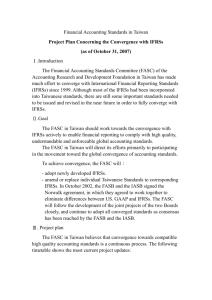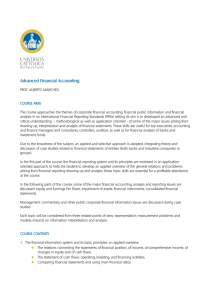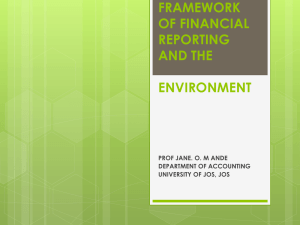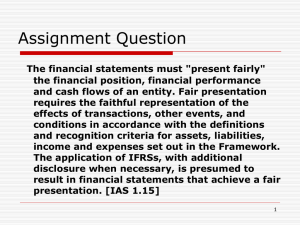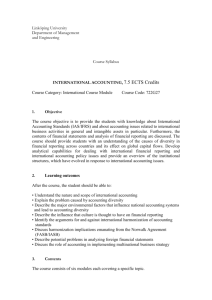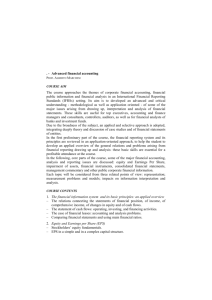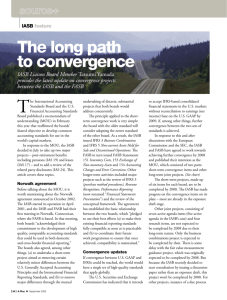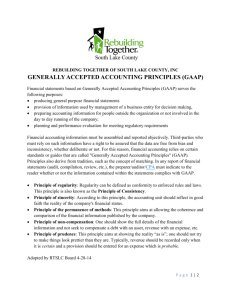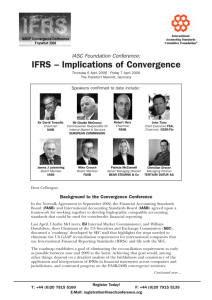international financial reporting standards
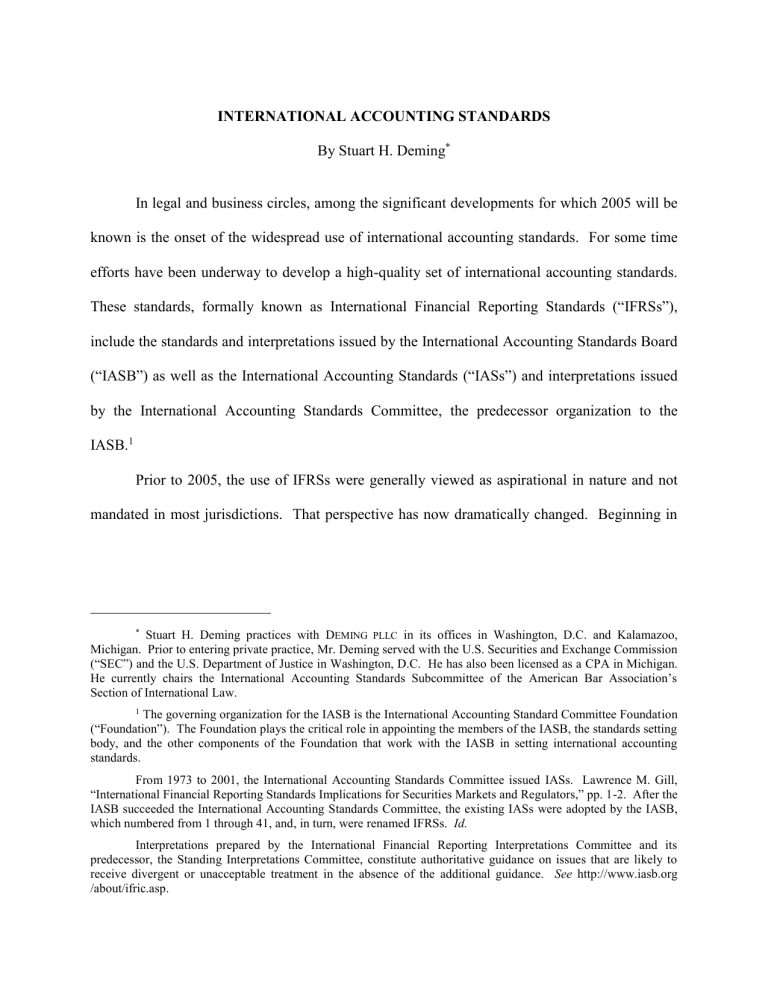
INTERNATIONAL ACCOUNTING STANDARDS
By Stuart H. Deming
*
In legal and business circles, among the significant developments for which 2005 will be known is the onset of the widespread use of international accounting standards. For some time efforts have been underway to develop a high-quality set of international accounting standards.
These standards, formally known as International Financial Reporting Standards (“IFRSs”), include the standards and interpretations issued by the International Accounting Standards Board
(“IASB”) as well as the International Accounting Standards (“IASs”) and interpretations issued by the International Accounting Standards Committee, the predecessor organization to the
IASB.
1
Prior to 2005, the use of IFRSs were generally viewed as aspirational in nature and not mandated in most jurisdictions. That perspective has now dramatically changed. Beginning in
* Stuart H. Deming practices with D EMING PLLC in its offices in Washington, D.C. and Kalamazoo,
Michigan. Prior to entering private practice, Mr. Deming served with the U.S. Securities and Exchange Commission
(“SEC”) and the U.S. Department of Justice in Washington, D.C. He has also been licensed as a CPA in Michigan.
He currently chairs the International Accounting Standards Subcommittee of the American Bar Association’s
Section of International Law.
1 The governing organization for the IASB is the International Accounting Standard Committee Foundation
(“Foundation”). The Foundation plays the critical role in appointing the members of the IASB, the standards setting body, and the other components of the Foundation that work with the IASB in setting international accounting standards.
From 1973 to 2001, the International Accounting Standards Committee issued IASs. Lawrence M. Gill,
“International Financial Reporting Standards Implications for Securities Markets and Regulators,” pp. 1-2. After the
IASB succeeded the International Accounting Standards Committee, the existing IASs were adopted by the IASB, which numbered from 1 through 41, and, in turn, were renamed IFRSs. Id.
Interpretations prepared by the International Financial Reporting Interpretations Committee and its predecessor, the Standing Interpretations Committee, constitute authoritative guidance on issues that are likely to receive divergent or unacceptable treatment in the absence of the additional guidance. See http://www.iasb.org
/about/ifric.asp.
2005, a Deloitte & Touche study indicates that 94 countries will require or permit the use of
IFRSs for publicly-traded companies and in other settings.
2
European Union
As of 2005, virtually all publicly-held companies listed on exchanges in the European
Union, including banks and insurance companies, are required to use IFRSs. Members of the
European Union have the option to extend this requirement to unlisted companies and to unconsolidated financial statements of parent companies.
3 Member countries may also defer the adoption of IFRSs until 2007 for companies whose only listed securities are debt securities or for companies listed on exchanges outside of the European Union that currently prepare their primary financial statements using generally accepted accounting principles (“GAAP”) not used in the European Union,
4
such as, in most cases, US GAAP.
5
In 2004, the European Commission adopted a regulation endorsing the adoption, with the exception of two “carve-outs,” of IAS 39 on Financial Instruments: Recognition and
Measurement. “The first carve-out related to certain provisions on the use of the Full Fair Value
2 http://www.iasb.org/news/index.asp?showPageContent=no&xml=10_678_25_24112005_23112006.htm.
See http://www.iasplus.com/country/useias.htm#*; see also http://www.iasb.org/about/faq.asp?showPageContent
=no&xml=18_18_24_17122003.htm.
3 http://www.iasplus.com/restruct/euro2005.htm#sep2005 .
4 Over the years most countries have developed a set of accounting principles that serve as a common basis for reporting the financial status of businesses operating within their borders. These common accounting principles are formally referred to as Generally Accepted Accounting Principles (“GAAP”). They are, in theory, unique to each country. Their purpose is to provide a common and accepted standard for evaluating and comparing the financial status of businesses.
5 http://www.iasplus.com/restruct/euro2005.htm#sep2005. It should be noted that the Committee of
European Securities Regulators (“CESR”) has concluded that the GAAPs of Canada, Japan and the United States, when each is taken as a whole, are equivalent to IFRSs. Id . The European Commission has therefore been advised by CESR “that non-European companies trading in European securities markets be allowed to submit financial statements in Canadian, Japanese, and US GAAP without a full reconciliation of their accounts to IFRSs. However, they must provide information about certain specific differences between those national GAAPs and IFRSs.” Id.
- 2 -
Option; the second to certain provisions on hedge accounting.”
6
Later, the IASB published an amended version of IAS 39, which satisfactorily addressed the concerns of the European
Commission as to the fair value carve-out and, accordingly, was reinstated.
7
This led, in turn, to
IAS 39 being adopted by the European Commission on a retroactive basis as of January 1, 2005.
8
The second carve-out, which related to hedge accounting, remained.
9
The European Union adopted in 2005 the 8th Company Law Directive on statutory audits of annual accounts and consolidated accounts.
10 The new directive calls for the use of
International Standards on Auditing (“IASs”) for all statutory audits conducted in the European
Union. The objective of the 8 th
Company Law Directive is to ensure that investors and other interested parties can rely fully on the accuracy of audited accounts to protect against the type of accounting scandals associated with companies such as Parmalat and Ahold.
The 8 th Company Law Directive requires audited companies to set up an audit committee, with independent members, which would oversee the audit process and communicate directly
6 See http://europa.eu.int/rapid/pressReleasesAction.do?reference=IP/05/884&format=HTML&aged=0&lan g uage=EN&guiLanguage=en.
7 “As a result of the [European Union] Adopting Regulation, the [European Union] is a significant force behind the global adoption of IFRS.” Lawrence M. Gill, “International Financial Reporting Standards Implications for Securities Markets and Regulators,” p. 4 (2005). Before it can be mandated by the European Union, an IASB standard or IFRIC interpretation must be adopted in accordance with the procedure established by Article 6(2) of
Regulation (EC) no 1606/2002 of the European Parliament and of the Council of 19 July 2002, OJ L 243,
11.09.2002. Id. at 3-4.
The procedure requires that the IASB standard or IFRIC interpretation be assessed by the
European Financial Reporting Advisory Group; then submitted to the European Parliament and the Accounting
Regulatory Committee; and, once it receives approval of a “qualified” majority member states in the Accounting
Regulatory Committee and the favorable opinion of the European Parliament, be formally adopted by the European
Commission. Id.
8 Id.
9 The European Commission has emphasized the need for the European Banking Federation and the IASB to come up with a resolution. In the interim, companies wishing to apply the ‘carved-out’ hedge accounting provisions could do so since there is an absence of applicable European Union law on the issue. Id.
10 http://europa.eu.int/rapid/pressReleasesAction.do?reference=IP/05/1249&format=HTML&aged=0&lang uage=EN&guiLanguage=en.
- 3 -
with the auditor.
11
The audit committee would also select the auditor and propose the appointment of the auditor to shareholders. Furthermore, if a company dismissed an auditor, it would need to explain the reasons to the relevant authority in the pertinent European Union country.
Other Countries
Australia,
12
New Zealand,
13
Hong Kong, Singapore, and the Philippines have adopted
IFRSs as have many countries bordering on the European Union.
14 For example, Iceland,
Liechtenstein, and Norway, though not members of the European Union, are members of the
European Economic Area. As such, they are committed to follow directives of the European
Union, including the accounting directives.
15
Switzerland, as of 2005, requires that multinational
“main board” companies listed within its jurisdiction to use either IFRSs or U.S. GAAP.
Many small or developing countries, like Jamaica, Kenya, Guatemala, Guyana,
Honduras, and Lebanon,
16
have turned to IFRSs as their GAAP. For example, in Malta the
Maltese Companies Act and tax regulations require that all limited liability companies prepare
11 See http://europa.eu.int/rapid/pressReleasesAction.do?reference=IP/05/1249&format=HTML&aged=0& language=EN&guiLanguage=en.
12 See http://www.deloitte.com/dtt/section_node/0,1042,sid%253D55617,00.html.
13 See http://www.iasplus.com/country/useias.htm.
14 The Philippines adopted, without modification, all of the IFRSs for 2005:
These Philippine equivalents to IFRSs apply to all entities with public accountability. That includes those whose securities are listed in a public market or are in process of listing; all financial institutions including banks, insurance companies, security brokers, pension funds, mutual funds, and investment banking entities; public utilities; and other economically significant entities, defined as total assets in 2004 of at least 250 million pesos (US$5 million) or liabilities of at least 150 million (US$3 million). The auditor's report will refer to “conformity with Philippine
Financial Reporting Standards”. http://www.iasplus.com/pastnews/2005nov.htm.
15 See http://www.iasplus.com/restruct/resteuro.htm#chrono.
16 See http://www.iasplus.com/country/useias.htm#*.
- 4 -
financial statements that comply fully with standards issued by the IASB and that those statements be audited in accordance with ISAs.
17
Convergence
Most countries are moving towards IFRSs. In April of 2005, Canada’s Accounting
Standards Board issued a draft strategic plan for the future direction of accounting standards in
Canada.
18
The plan calls for Canadian standards for publicly-held companies to converge with
IFRSs over a five-year transitional period. At the end of that period, Canadian standards would cease to exist as a separate basis of financial reporting for publicly-held companies. Similarly, the Canadian Auditing and Assurance Standards Board has issued an invitation to comment on its new standard-setting approach, which proposes the convergence of Canadian Auditing and
Assurance Standards with ISAs and with the pronouncements of the International Auditing and
Assurance Standards Board.
19
China has announced that convergence with IFRSs is one of the fundamental goals of its standard-setting program.
20
Its Accounting Standards System for Business Enterprises is being developed with a view to achieving convergence of those standards with the equivalent IFRSs.
China has taken the position that an enterprise applying China’s accounting standards should produce financial statements that are the same as those of an enterprise that applies IFRSs.
In 2004, the IASB and the Accounting Standards Board of Japan agreed to initiate discussions about a joint project to minimize differences between IFRSs and Japanese
17 http://www.iasplus.com/pastnews/2005oct.htm.
18 http://www.acsbcanada.org/multimedia/Download_Library/Standards/Accounting/English/e_AcctStds
DraftStrategicPlan.pdf.
ISAs”).
19 http://www.iasplus.com/index.htm (“26 November 2005: Canada proposes audit convergence with
20 http://www.iasb.co.uk/; (go to “ISB and IASC Foundation News”, then go to “Bold Steps Toward
Convergence of Chinese Accounting Standards and International Standards”).
- 5 -
accounting standards with the ultimate goal of convergence of their standards.
21
In January of
2005, the two boards announced their agreement to launch a joint project to reduce differences between IFRSs and Japanese accounting standards.
Convergence with US GAAP
From the perspective of the United States, both the SEC and Financial Accounting
Standards Board (“FASB”) are very supportive of convergence.
22
Formal efforts have been underway for a number of years to narrow the differences. But the movement towards convergence will continue to be incremental as a number of major differences have yet to be resolved.
For some time, the SEC has allowed foreign issuers registered with the SEC to use IFRSs in meeting their requirement of providing three years of audited financial statements prepared on a consistent basis.
23 That reconciliation period was reduced in 2005 to two years. Eligible issuers are now permitted to file two years rather than three years of statements of income, changes in shareholders' equity and cash flows prepared in accordance with IFRSs in annual reports and registration statements filed during the first year in which they adopt IFRSs.
Consistent with the move towards convergence, the SEC announced in 2005 what was described as a 'roadmap' of steps, developed by its staff, needed for the elimination of the requirement for reconciliation with US GAAP for non-US companies listed in the United
States.
24
Indeed, the European Union reached an agreement in 2005 with the SEC to remove the requirement as early as 2007, and no later than 2009, that they reconcile to US GAAP.
25
21 See http://www.iasb.co.uk/.
22 See, e.g., http://www.fasb.org/intl/.
23 See http://www.sec.gov/news/press/2005-55.htm
24 See http://www.sec.gov/news/press/2005-62.htm.
25 See http://www.iasplus.com/pastnews/2005oct.htm.
- 6 -
Impact of IFRSs on US GAAP
As they become the prevailing international accounting standards, the impact of IFRSs on
US GAAP will only increase with convergence. Given the dominance of the United States as a source of capital, foreign companies are accustomed to using US GAAP in order to raise capital in the United States. US GAAP impacts on all aspects of decision making with respect to the conduct of U.S. business and in the conduct of business in many parts of the world.
However, the dominance of US GAAP can no longer be assumed. Nor can it be assumed that US GAAP will continue to be the primary means by which businesses and business relationships are evaluated. U.S. companies, financial institutions, investors, and the lawyers for each must increasingly take into consideration IFRSs, and their implications, on a wide range of issues relating to the operation of a business. Similar considerations should be undertaken by non-U.S. companies and financial institutions which have customarily used US GAAP.
Differences between IFRSs and US GAAP
In an overall sense, IFRSs and US GAAP are far more similar than they are different.
The influence of US GAAP and U.S. practices on IFRSs is substantial. As opposed to historical cost, both IFRSs and US GAAP are increasingly based on a fair value asset and liability model.
IFRSs is generally viewed as being more principles-based in orientation than US GAAP, which is viewed as more being rule-based. By analogy and practice, IFRSs take more of a common law approach whereas US GAAP represents an approach similar to the civil law.
Impact of IFRSs on U.S. Companies
For U.S. companies, the broader their international activities, the more significant will be the effect of IFRSs. Differences between the two standards exist. Unlike US GAAP, which does not require a parent and subsidiaries to conform their accounting policies, IAS 27 under IFRSs
- 7 -
requires a parent to present consolidated financial statements for subsidiaries it controls using uniform accounting policies.
For U.S. subsidiaries of companies operating in jurisdictions like the European Union where IFRSs represent the accepted standard, the same accounting standards as their corporate parent will need to be followed. A subsidiary’s accounting policies must conform to its parent’s accounting policies under IFRSs for similar transactions and events.
26
Similarly, U.S. joint ventures with a venture partner operating in countries requiring the application of IFRSs will need to follow the same accounting standards as their venture partner.
If a listed European Union company has a major investment in a U.S. company, the U.S. company will have to prepare information according to IFRSs for purposes of its investor’s equity accounting.
Even for companies not required to adopt IFRSs for reporting purposes, many U.S. companies looking to new markets will need to adopt IFRSs to secure licenses, raise capital, or comply with requirements of local regulators. Foreign customers, vendors, or lessors may also require the use of IFRSs.
Importance of Differences in Accounting Standards for Lawyers
Yet, despite their common heritage and the movement toward convergence, the differences between IFRSs and US GAAP can at times be significant. From a legal standpoint, the differences can have dramatic ramifications. Most significant are the critical disclosure obligations that may arise to shareholders. Conversion to IFRSs may be material in a number of respects.
26 For example, IAS 2 under IFRSs prohibits the valuation of inventory on the basis of the last-in, first-out method. But the last-in, first-out method is permitted under US GAAP. The U.S. subsidiary of a parent company located in the European Union would have to use the average cost or first-in, first-out methods, whichever is used by its parent, as the method of valuing its inventory.
- 8 -
The SEC’s staff has taken the position that issuers should include a “discussion of the impact of the standard is expected to have on the financial statements of the registrant, unless not known or reasonably estimable. In that case, a statement to that effect may be made.”
27
Disclosure is also encouraged of other significant matters that the registrant believes might result from the adoption of the standard (such as technical violations of debt covenant agreements, planned or intended changes in business practices, etc.) . . . .”
28
Disclosures may also be required relative to the implications of a change in accounting standard on important ratios. Of the information required to be disclosed by Form 6-K for foreign issuers registered with the SEC,
29
a change in accounting standards may have an impact on “the financial condition and results of operations,” “defaults upon senior securities,” “material increases or decreases in the amount outstanding of securities or indebtedness,” and “the granting of options or payment of other compensation to directors or officers.” 30
In addition, special care must be exercised in the drafting of legal instruments which are tied to the financial statements of a company. For legal instruments linked to information contained in financial statements of entities now in the process of converting to IFRSs, the parties to those instruments, and their attorneys, need to review the provisions of the legal instruments to determine the impact of the change to IFRSs. The provisions may need to be revised or clarified or, alternatively, new arrangements may need to be negotiated. But the impact of the change to IFRSs cannot be disregarded.
27 SEC Staff Accounting Bulletin 103: Codification of Staff Accounting Bulletins, Topic 11 M, 17 C.F.R.
Part 211 (http://www.sec.gov/interps/account/sabcode11.htm#11m).
28 Id.
29 17 C.F.R. § 249.306.
30 Form 6-K, General Instructions, Part B, p. 2 (http://www.sec.gov/about/forms/form6-k.pdf)
- 9 -
Henceforth, agreements dependent in whole or in part on information in financial statements should, much like choice-of-law provisions in contracts, clearly define what accounting standards govern financial statements to which they are linked. Drafters of legal instruments must take into consideration what accounting standards apply or are likely to apply and the implications of their application.
But the designation of applicable accounting standards in legal instruments must be an informed decision. Simply designating the governing standards can be counterproductive if conversion costs are not adequately considered. In many situations, conversion costs can be substantial. At times, incurring substantial conversion costs may be warranted. Yet, in many situations, the conversion costs cannot be justified, and functionally equivalent alternatives may need to be identified.
31
The Emergence of IFRSs as a Set of Global Standards
But even with the emergence of IFRSs, a difference can still exist between IFRSs as adopted by the IASB and as adopted by the European Union or a particular country. Much like the adoption of uniform laws by individual states in the United States, in adopting IFRSs, the
European Union and some countries have made relatively modest modifications. As a result, any reference to IFRSs should not be unqualified.
Reference to the pertinent adopting body in referring to accounting standards is always prudent as a means of clarification. IFRSs, as adopted by the IASB, should be the point of reference for the unaltered standards. For example, IFRSs as adopted by the European Union or
31 For example, other financial ratios or line items might be used to provide similar information which will not change depending upon whether IFRSs or US GAAP is used. Reference might also be made to financial information that is entirely separate from financial statements or data that cannot be affected by a change in accounting standards.
- 10 -
a particular country should be referred to as the respective version of IFRSs for the European
Union or the particular country.
Conclusion
While in the offing for many years, the convergence to IFRSs has now begun in earnest.
No longer can US GAAP be assumed to be the accounting principles that govern the issuance of reports as to the financial status of business entities or that govern how the financial status of business entities are evaluated. Increasingly, particular care will need to be exercised by those providing legal advice to determine the implications of a change in accounting standards or the implications of accounting standards currently being used.
- 11 -
